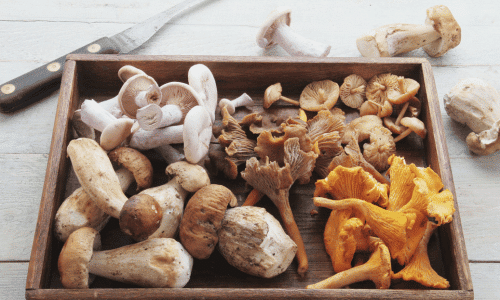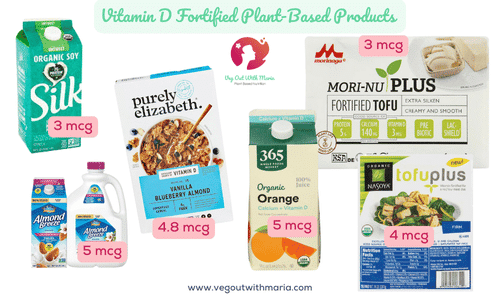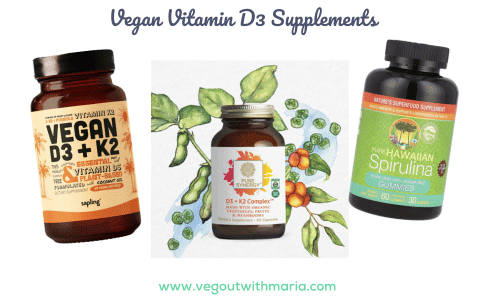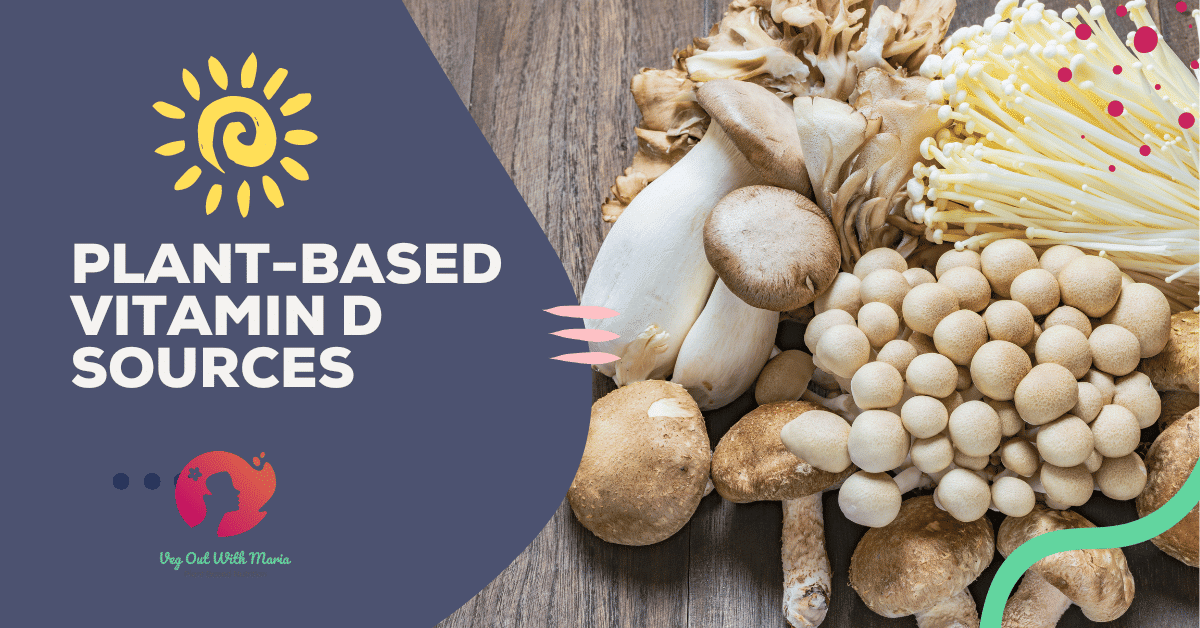Vitamin D is important not only for bone health but it also plays a crucial role in your heart and brain health, muscle strength, and immune function and provides anti-inflammatory benefits.
The challenge is ensuring you’re getting enough of it! Very few foods contain vitamin D. This is especially true if you’re plant-based.
This blog will break down the best plant-based sources of vitamin D, how to optimize sun exposure, and if and how much you need to supplement.
Understanding Vitamin D
*This post contains affiliate links. As an Amazon Associate, I earn from qualifying purchases.
What is Vitamin D?
Vitamin D is a unique nutrient. It is both a fat-soluble vitamin that you get from food and supplements and a hormone (calcitriol) that your body can make to help you absorb calcium.
What is a fat-soluble vitamin, you ask? A fat-soluble vitamin is a vitamin that dissolves in fats and oils and is absorbed into the body along with dietary fats. Then it is stored in the body’s fatty tissue and liver, where it can be accessed as needed.
There are two main forms of vitamin D:
Vitamin D2 (Ergocalciferol):
- Source: Primarily obtained from plant-based sources and fungi, such as mushrooms exposed to UV light and fortified foods.
- Function: It is synthesized by plants and converted into its active form in the human body. However, it is generally considered less effective at raising blood levels of vitamin D compared to vitamin D31,2.
Vitamin D3 (Cholecalciferol):
- Source: Found in animal-based foods such as fatty fish, liver, and egg yolks, and also produced by the skin when exposed to sunlight (specifically UVB rays).
- Function: More effective than vitamin D2 at raising and maintaining overall vitamin D levels in the blood. It is the preferred form for supplementation due to its higher potency and longer duration of action in the body.
Benefits of Vitamin D
Probably the most well-known benefit of vitamin D is its effect on bone health. But, research has also linked vitamin D to many other health benefits. There are vitamin D receptors located throughout your body including the brain, immune cells, gastrointestinal tract, muscles, heart, and skin.
1. Bone Health
Calcium Absorption: Vitamin D is essential for the absorption of calcium, promoting strong and healthy bones. It works in the small intestine enhancing calcium absorption from the foods that you eat.
Bone Growth and Remodeling: Supports bone growth and prevents bone diseases like osteoporosis and rickets.
2. Immune Function
Immune System Regulation: Enhances the pathogen-fighting effects of the immune system and reduces inflammation.
Infection Prevention: Associated with a lower risk of infections such as colds, flu, and respiratory illnesses. Vitamin D supplementation has also been shown to reduce COVID-19 risk, especially for African Americans and those with low vitamin D levels3.
3. Mental Health
Mood Regulation: Linked to improved mood and reduced symptoms of depression and anxiety4.
Seasonal Affective Disorder (SAD): low vitamin D levels have also been associated with symptoms of SAD, a type of depression related to seasonal changes.
4. Cardiovascular Health
Heart Function: Vitamin D influences blood pressure regulation and heart muscle function and may be beneficial for those with congestive heart failure5.
Risk Reduction: Lower levels are associated with an increased risk of heart disease and hypertension. Vitamin D supplementation might reduce the risk of major cardiovascular events6.
5. Muscle Function
Muscle Strength: Contributes to muscle strength, reducing the risk of falls, particularly in older adults7,8.
6. Anti-Inflammatory Effects
Chronic Disease Prevention: Reduces the risk of chronic diseases such as type 2 diabetes, certain cancers, and autoimmune conditions due to its anti-inflammatory properties9,10.
Common Causes of Vitamin D Deficiency
You would think it would be easy to get enough vitamin D, especially since you can get it from sun exposure. However, even in a place like Hawaii where there is sun all year round, there is still a high incidence of vitamin D deficiency. Why is that?
Limited Sun Exposure
- Geographic Location: Not everyone lives in Hawaii. Living in higher latitudes with less sunlight, especially during the winter months decreases your exposure.
- Indoor Lifestyle: Spending most of the time indoors, reducing exposure to sunlight.
- Sunscreen Use: Using sunscreen that blocks UVB rays necessary for vitamin D synthesis in the skin.
Skin Pigmentation
- Darker Skin: Higher melanin levels reduce the skin’s ability to produce vitamin D from sunlight.
Age
- Older Adults: The skin’s ability to synthesize vitamin D decreases with age, and older adults may spend more time indoors.
Medical Conditions
- Malabsorption: Conditions like Crohn’s disease, celiac disease, cystic fibrosis, and procedures like gastric bypass surgery that affect the absorption of nutrients.
- Obesity: Vitamin D is fat-soluble, so people with more body fat store it in fat cells, which keeps it from circulating in the blood. It is also believed that people with obesity need 2 to 3 times the supplemental dose11,12.
- Kidney and Liver Diseases: Impair the conversion of vitamin D to its active form.
Dietary Insufficiency
- Low Intake of Vitamin D-Rich Foods: Not consuming enough foods that are naturally rich in vitamin D or fortified with it.
Top Plant-Based Sources of Vitamin D
Most of the vitamin D we get from our diet comes from fortified foods since very few foods contain vitamin D.
The top foods that naturally contain vitamin D are fatty fish and cod liver oil. Per USDA 1 Tbsp cod liver oil contains 1360 IU (34 mcg) and 3 oz of salmon contains 570 IU (14.2 mcg). You can also find a small amount in liver and egg yolks.
But, what about plant-based sources of vitamin D? The list is not long, unfortunately, but let’s take a look at the top sources:
1. Mushrooms

Fungi wins the prize! Mushrooms have the ability to synthesize D2 when exposed to UV light. But, not all mushrooms are good sources of vitamin D. In fact, most commercially grown mushrooms are grown in the dark and contain very little D2.
However, some wild mushrooms and those treated with UV light can be great sources of vitamin D. It only takes about 3 seconds of UV exposure to do the trick. Per USDA, just 1 cup (87g) of UV-treated whole brown or crimini mushrooms can contain over 1.100 IU (27.8 mcg)13.
These vitamin D-enhanced mushrooms offer high concentrations of vitamin D2 and are bioavailable and fairly stable during storage and cooking14.
2. Fortified Plant-Based Products
Yep, we are already on the fortified foods list. While not providing a lot of vitamin D, incorporating a few of these products into your diet does add up. Note that most fortification uses D2 so it will be vegan.
Fortified Plant-Based Milk
Not all plant-based milk is fortified with vitamin D. Some are made with very few ingredients and no additives which is good for people with food sensitivities but also means it will not contain vitamin D. I mention some of these options in High Protein Plant-Based Milk – Top Picks.
For those that are fortified, the amount of vitamin D depends on the brand. Silk Organic Unsweetened Soy Milk contains 3 mcg per 1 cup serving. Silk Unsweetened Almond Milk contains 2 mcg per serving while Blue Diamond Almond Breeze contains 5 mcg per serving.
Fortified Plant-Based Yogurt
Again, not all plant-based yogurt is fortified with vitamin D but here are a couple: Silk Vanilla Almond Milk Yogurt contains 2.3 mcg per 3/4 cup. So Delicious Unsweetened Vanilla Coconut Yogurt has 2.0 mcg.
Fortified Tofu
Most of the tofu you find in stores is not fortified. I did find a couple of options though: Mori-Nu Plus Fortified Tofu Extra Silken contains 3 mcg per 3 oz serving. Nasoya Tofu Plus Firm has 4 mcg per 3 oz (85g).
Fortified Cereal
Kashi makes a couple of cereals with added vitamin D: Blueberry Almond and Cinnamon Walnut which contain 4.0 mcg per 3/4 cup. Another good option is Purely Elizabeth Blueberry Almond cereal which contains 4.8 mcg per 2/3 cup.
Fortified Juice
I would much rather eat my fruit but if you’re into drinking juice there are a few brands that fortify with vitamin D. Orange juice was the only juice I could find that was fortified with vitamin D. If you find another juice let me know!
Simply and Tropicana orange juice both offer fortified options with 2.5 mcg of vitamin D per cup (240 ml). Whole Foods 365 Brand of organic orange juice steps it up with 5 mcg per cup. I noticed this one uses D3 but states on the label that it’s vegetarian.
Fortified Yeast
Some nutritional yeast is fortified with vitamin D like Wholier Nutritional Yeast Flakes.* It has added vitamin B12 + 10 mcg of vegan vitamin D3 per 2 Tbsp.

3. Sun Exposure
Of course, sunshine isn’t a food but it is definitely certified as a vegan-friendly way to get your D! Any part of your body can be exposed to get Vitamin D and you only need about 10-30 minutes of exposure. For darker skinned people you may need a little longer.
Midday has the most UVB rays and would offer the most vitamin D production. However, I recommend getting direct sunlight during the early morning hours (or later afternoon) when the UVB rays are lower. Less damage to your skin!
Early morning sun also helps set your circadian rhythm, boosting hormone production (including melatonin), and improving your sleep cycle.
Just note some of the drawbacks mentioned earlier about getting enough vitamin D from the sun. This is why you can’t always depend on it to meet your D needs.
How Much Vitamin D Do You Need?
The recommended dietary allowance for vitamin D is 15 mcg (600 IU) daily for men and women up to age 70. Beyond 70 the recommendation increases to 20 mcg (800 IU).
However, the Endocrine Society suggests that at least 1,500–2,000 IU/day may be needed to maintain adequate blood levels of vitamin D (25[OH]D)13.
You’ll find a common recommended supplemental dose is between 1,000-2,000 IU (25-50 mcg) with a suggested upper limit of 4,000 IU daily for a maintenance dose. More is not always better!
Vegan Vitamin D3 Supplements
We’ve covered a few plant-based vitamin D sources, but what about supplements? Do you need to take a vitamin D supplement if you’re plant-based?
Plant-based or not, it is difficult for most people to get enough vitamin D through food alone. I would supplement especially during the winter months when there is less opportunity to be in the sun. Also, vitamin D becomes even more important once you start going through perimenopause and menopause to protect your bone health.
Most vitamin D3 supplements are not vegan or vegetarian-friendly though. That’s because they are made using lanolin which is basically wool fat from sheep. Thankfully, there are now plenty of vegan options that use lichen a unique type of fungi/algae that naturally grows in soil and on trees and rocks.
Not only is lichen a great source of vitamin D3, but it comes from plants, is free of pesticides and other contaminants, and is environmentally friendly.
Ideally, your vitamin D supplement should come with vitamin K2. K2 ensures that the calcium you absorb (thanks to vitamin D) is shuttled into the bone where it belongs instead of depositing in your soft tissues and arteries14.
I’ve found it difficult to find a vegan D3 supplement that also contains vitamin K2 in addition to containing doses 4,000 IU or lower.
Below are a few recommendations:
- Sapling Vegan D3 + K2.* I like supporting this company because they are a small business that gives back. For every product purchased a tree is planted. Pretty cool!
- Pure Synergy D3 + K2
- Complement Essential* multivitamin.
- Nutrex Hawaii Pure Spirulina Superfood Gummies + Vitamin D3.* This product naturally contains vitamin K and B12 although amounts are not listed. I also like to support Hawaiian companies and think it’s a fun vitamin D option.

Plant-Based Vitamin D ~ Summary
Vitamin D is essential for maintaining bone and cardiovascular health, supporting immune and muscle function, and providing anti-inflammatory benefits. All of which become very important as you navigate through perimenopause and menopause.
Try to incorporate some of these plant-based sources of vitamin D and take advantage of the sun when you can at optimal times without harming your skin. That being said, relying solely on plant-based sources and sunlight may not be sufficient to consistently meet your vitamin D needs.
Incorporating a daily vegan D3 supplement, especially one combined with vitamin K2, can ensure you maintain optimal vitamin D levels for overall health. This approach helps bridge the gap, providing a reliable and consistent source of this vital nutrient.


